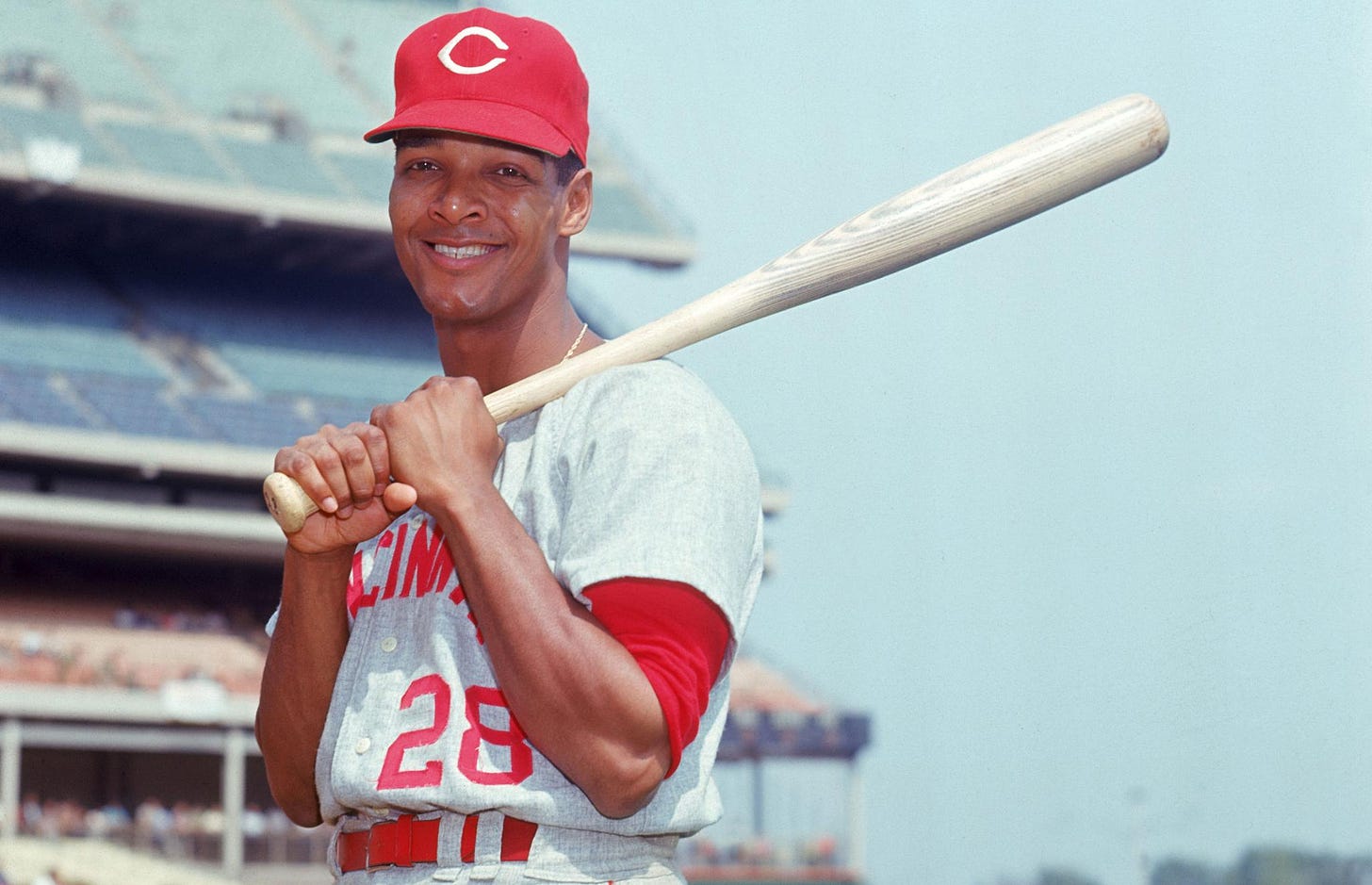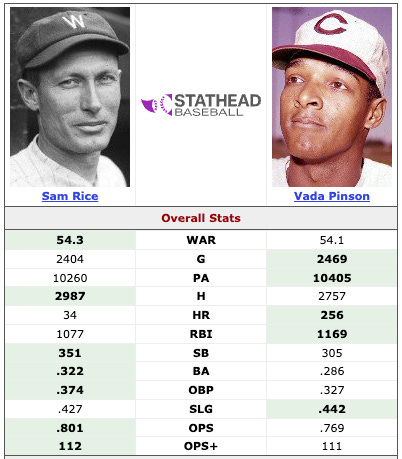
Baseball Remembers: Vada Pinson
Commending His Professional Accomplishments on His Birthday
Today marks the 85th anniversary of Vada Pinson’s birth. Regrettably, he succumbed to the consequences of a stroke in 1995 at the age of 57. Although his career is no longer widely discussed, his birthday provides a fitting occasion to remind people of his exceptional talent.

According to the regulations in place at that time, Pinson surpassed the restrictions imposed on rookies in 1958, even though he only participated in 27 games and had a mere 110 plate appearances. At the beginning of the year, he was just 19 years old and had joined the Reds for the season, but he faced difficulties. He was not demoted to the minor leagues until mid-May.
According to the existing regulations for rookie eligibility, it is likely that he would have been classified as a rookie in 1959. If this were the case, he would have enjoyed one of the most exceptional rookie seasons since World War II. Pinson participated in all 154 games of Cincinnati and achieved the highest number of plate appearances (706), runs (131), and doubles (47) in the National League. He was listed as a participant in both All-Star games that year, achieved 20 home runs, 21 stolen bases, and had a batting average of .316. He amassed over 200 hits, achieving this feat on four separate occasions. Additionally, he accumulated a WAR (Wins Above Replacement) of 6.5, matching the impressive mark achieved by his teammate Frank Robinson, who had won the Rookie of the Year award three years prior. Pinson was a mere 20 years old.
In 1960, he replicated his previous accomplishment by once again leading the league in plate appearances (707) and doubles (37). He also earned a spot on both All-Star rosters, hit an additional 20 home runs, and accumulated a WAR of 5.6. That became his standard practice for the subsequent seasons. Consistently achieving an on-base plus slugging (OPS) between .820 and .880, hitting approximately 20 home runs, stealing close to 25 bases, accumulating around 200 hits, and attaining a wins above replacement (WAR) value ranging from 5.0 to 7.5. The statistical performance of his career up until the age of 26 closely resembled that of another outfielder from the same era who made his debut in the major leagues as a teenager.

Undoubtedly, Al Kaline ranks among the most exceptional right fielders in the annals of baseball. He achieved over 3,000 hits and only missed hitting 400 home runs in his career. As soon as he became eligible in 1980, he was voted to the Hall of Fame.
However, Pinson did not manage to reach that point. He maintained his durability for a few more seasons, and even topped the National League in triples in 1967, but his overall effectiveness declined. He transitioned from consistently achieving an OPS that beyond the average of the leagues he played in by 20 to 30 percent, to abruptly having a superiority of only 5 percent. From a defensive standpoint, he consistently displayed a high level of skill as a centerfielder, occasionally reaching an exceptional level. This was evident in his achievement of winning a Gold Glove in 1961, a recognition that he well deserved. The performance also declined. In 1968, his performance in center field was 11 runs below the average, prompting a shift to either right or left field for the most of his career thereafter.
Following that season, the Reds transferred him to St. Louis, where his decline persisted. Despite being only 30 years old, he achieved a meager 92 OPS+ and a WAR just slightly above the replacement level at 0.6. The season was unsatisfactory, leading the Cardinals to trade him to Cleveland after only one year.
Pinson experienced a moderate recovery in 1970, achieving a career peak of 24 home runs in 148 games, resulting in a 2.3 Wins Above Replacement (WAR). However, he was unable to maintain this level of performance. Following a year of underwhelming performance in 1971 (with an OPS+ of 83 and a WAR of 0.6), he was once again dealt, this time to the Angels.
He had a comparable two-year experience there to the ones he had recently completed in Cleveland. In the initial year, the player performed well, achieving a 113 OPS+ and 2.4 WAR. However, in the subsequent year, their performance declined significantly, resulting in a 91 OPS+ and 0.4 WAR. Following the 1974 season, Pinson was sent to the Royals, where he had two underwhelming seasons before being let go.
He attempted to join the Brewers for the 1976 season, but was unable to get a spot on the team during spring training and was subsequently released, marking the end of his playing career. At the age of 37, he continued coaching for several teams for the most of the following two decades until his untimely death due to a stroke.
The aggregate statistics of his career seem to be remarkable. He accumulated a total of 2,757 hits, close to 1,400 runs, 1,200 runs batted in (RBI), more than 250 home runs, and over 300 stolen bases. His career Wins Above Replacement (WAR) of 54.1 is approximately equal to that of Hall of Famer Sam Rice, and he achieved this in a similar number of plate appearances.

Pinson’s predicament, from the standpoint of the Hall of Fame, is that he failed to capitalize on many opportunities that would have bolstered his career in the eyes of the voting committee. In contrast to Rice, he never achieved victory in a World Series, and had a subpar performance in the sole appearance we made in the tournament. His lifetime batting average fell below .300, whereas Rice achieved a batting average of .322. He fell short of achieving significant milestones including as 3,000 hits, 300 home runs, and 1,500 RBI. He failed to secure a batting title or an MVP honor. Alternatively, as previously mentioned, Rookie of the Year.
The main issue he faces is that his career can only be favorably compared to those of Hall of Famers who were, at most, on the edge of being selected themselves. He ranks 20th among centerfielders in Jay Jaffe’s JAWS system, a position that is considered respectable. However, he falls between non-Hall-of-Famers César Cedeño and Chet Lemon. Although Pinson’s performance closely paralleled Al Kaline’s statistics up until their 26th seasons, Pinson ultimately fell behind. Here is a breakdown of their next ten years:

Pinson’s inability to equal Kaline was not due to playing time or health. The event was a performance. He exhibited a noticeable decline in his performance compared to his earlier years, whilst Kaline actually demonstrated slight improvement.
There is no fault or flaw in that, and it does not diminish the excellence of Pinson’s career. No, he is unlikely to meet the criteria for induction into the Hall of Fame. However, if he were to be chosen in the future, it would not be considered a disgraceful decision. While it is improbable, he remains among the top 20-25 players in his position throughout the history of the game. That is worth remembering, particularly on his birthday.